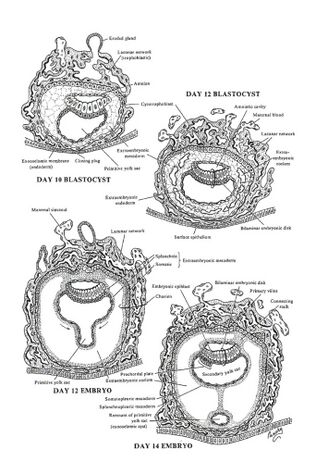1,5. The second week of development
Learning objectives
- Describe the differentiation of the trophoblast
- What is the amniotic cavity?
- What occurs during the lacunar stage of the trophoblast?
- What does the primitive yolk sac arise from?
- Describe the establishment of the uteroplacental circulation
- Where does the chorionic cavity arise?
- Which structure will eventually give rise to the umbilical cord?
- What occurs during the decidua reaction, and what is its purpose?
- Describe the structure of the primary villi
- Describe the formation of the secondary yolk sac
The week of 2’s
The second week of gestation is known as the week of 2’s:
- The trophoblast differentiates into two layers: the cytotrophoblast and the syncytiotrophoblast
- The embryoblast differentiates into two layers: the epiblast and the hypoblast
- The extraembryonic mesoderm splits into two layers: the extraembryonic somatic and the extraembryonic splanchnic mesoderm
- Two cavities are formed, the amniotic cavity and the yolk sac
Day 8

Differentiation of the trophoblast
As the blastocyst continues to invade into the uterus the trophoblast starts to differentiate into two layers: the syncytiotrophoblast and the cytotrophoblast.
The cytotrophoblast is the inner layer of the trophoblast. The cytotrophoblast is mitotically active and continue replicates, providing cells both for itself and for the syncytiotrophoblast.
The syncytiotrophoblast is the outer layer of the trophoblast. This layer has no distinct boundaries between the cells – it’s rather a multinucleated protoplasmic mass than a layer of cells. The syncytiotrophoblast begins to invade deeper into the endometrial stroma.
The endometrial stroma close to the site of implantation is oedematous (swollen) and highly vascular. Large tortuous glands secrete glycogen and mucus.
Formation of the amniotic cavity
A small cavity appears within the epiblast – the amniotic cavity. The epiblast cells directly adjacent to the amniotic cavity are called amnioblasts.
Day 9
The lacunar stage of the trophoblast
The blastocyst is now almost completely embedded in the endometrium. Vacuoles form in the syncytiotrophoblast, which fuse to form trophoblastic lacunae. This signifies the lacunar stage of the trophoblast.
The primitive yolk sac
The blastocyst cavity becomes lined with flat cells originated from the hypoblast. This lining is called the exocoelomic membrane or the Heuser membrane. At this point the blastocyst cavity becomes the exocoelomic cavity, also called the primitive yolk sac.
Days 11 and 12
Establishment of the uteroplacental circulation
By now the blastocyst is completely embedded in the endometrium. The syncytiotrophoblast penetrates deep into the stroma, eroding the endothelial lining of dilated maternal capillaries called sinusoids. The trophoblastic lacunae become continuous with the sinusoids, causing maternal blood to enter the lacunae. This is the beginning of the uteroplacental circulation.
Establishment of the chorionic cavity
A new population of cells appears between the inner surface of the cytotrophoblast and the exocoelomic membrane. These cells form the extraembryonic mesoderm.
Large cavities develop inside the extraembryonic mesoderm, which will eventually become confluent a form a new space called the chorionic cavity or the extraembryonic cavity.
The extraembryonic mesoderm which lines the cytotrophoblast and the amniotic cavity is called the extraembryonic somatic mesoderm; the extraembryonic mesoderm which lines the primitive yolk sac is called the extraembryonic splanchnic mesoderm. That is, the somatic one is the outer layer while the splanchnic one is the inner layer.
The chorionic cavity extends and surrounds the primitive yolk sac and the amniotic cavity, except where the germ disc is connected to the trophoblast by a connecting stalk. When this connecting stalk develops blood vessels it will become the umbilical cord.
The decidua reaction
During the decidua reaction the endometrium undergoes morphological and functional changes, causing it to change into a new structure called the decidua. The decidua promotes the invasion of the trophoblast.
This reaction involves endometrial stromal cells becoming polyhedral and loaded with glycogen, lipids, and fluids.
Day 13
Primary villi
Cells of the cytotrophoblast grow, together with an outer syncytiotrophoblast layer, finger-like projections into the endometrium called primary villi.
Secondary yolk sac
The hypoblast produces new cells which divide the primitive yolk sac into two cavities, the secondary or definitive yolk sac, and the exocoelomic cyst.
Summary of the occurrences during week 2. From here
Summary
- Describe the differentiation of the trophoblast
- The trophoblast differentiates into the syncytiotrophoblast and the cytotrophoblast
- The syncytiotrophoblast is the outer layer which has no boundaries between the cells
- The cytotrophoblast is the inner layer, which is mitotically active
- What is the amniotic cavity?
- The amniotic cavity is a cavity which forms inside the epiblast
- What occurs during the lacunar stage of the trophoblast?
- Vacuoles and later lacunae form inside the syncytiotrophoblast
- What does the primitive yolk sac arise from?
- The primitive yolk sac arises from the blastocyst cavity
- Describe the establishment of the uteroplacental circulation
- As the syncytiotrophoblast penetrates deep into the endometrial stroma it erodes dilated maternal capillaries called sinusoids
- Blood from the sinusoids enters the lacunae
- Where does the chorionic cavity arise?
- It arises inside the extraembryonic mesoderm
- Which structure will eventually give rise to the umbilical cord?
- The connecting stalk gives rise to the umbilical cord after blood vessels have developed in it
- What occurs during the decidua reaction, and what is its purpose?
- During the decidua reaction endometrial stromal cells become polyhedral and loaded with glycogen, lipids, and fluids
- The reaction promotes invasion of the trophoblast
- Describe the structure of the primary villi
- It has a stem of cytotrophoblast and a layer of syncytiotrophoblast on the surface
- Describe the formation of the secondary yolk sac
- The hypoblast produces new cells which divide the primitive yolk sac into two cavities, the secondary or definitive yolk sac, and the exocoelomic cyst.
